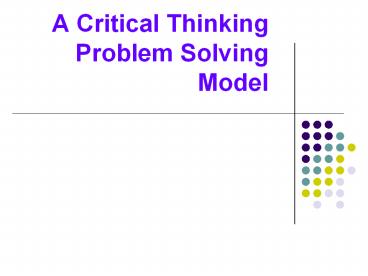A Critical Thinking Problem Solving Model - PowerPoint PPT Presentation
1 / 20
Title:
A Critical Thinking Problem Solving Model
Description:
A Critical Thinking Problem Solving Model Problem Solving Content Issues Description of Problem Factors: Constructive vs Limiting Ownership Scope of Problem ... – PowerPoint PPT presentation
Number of Views:174
Avg rating:3.0/5.0
Title: A Critical Thinking Problem Solving Model
1
A Critical Thinking Problem Solving Model
2
Problem Solving Content Issues
- Description of Problem
- Factors Constructive vs Limiting
- Ownership
- Scope of Problem
- Consequence of Problem
- Alternative Solutions
- Rank Ordered Solutions
3
Process Issues in Problem Solving
- Self-awareness of the problem solver
- Motivation of the problem solver
- Decision making involved in selecting solution by
solver - Execution of the solution decided upon
4
Problem Solving Model
5
Components of Problem
6
Visceral Components of the Problem
- Size of Problem - costs, risks, losses
- Sensory Input
- Hows it look?
- Hows it sound?
- Hows it taste?
- Hows its smell?
- Hows it feel?
7
Personal Components of the Problem
- If on Team other members as problem solvers
their perspective
- Inside perspective of problem solver of the
problem
8
What is Needed to Improve Problem Solving Process
- Unconditional acceptance non-judgmental
attitude of fellow problem solvers - Respect for each participants input
- Freedom to openly express emotional response to
the problem solutions - Defined limits boundaries on problem solving
process
9
Encouraging Creativity in Problem Solving
- Create the desire to be creative-a person must
want it - Expand Knowledge Skills of language by reading
more to be creative thinker - It takes effort to create-genius is 1
inspiration 99 perspiration-Edison - Ferment creativity - give it time
- Evaluate validate creative ideas
10
Brainstorming
- Set a time frame to be completed
- Be clear what problem you are trying to solve
- All ideas should be heard
- No idea is too wild to be expressed
- Quantity is wanted each idea coming to mind
should be expressed - Combining ideas for improvement is highly
desirable - Criticism or negative discussion regarding ideas
is absolutely forbidden
11
Starbursting
- Focuses on a topic radiates outward with
questions - Here anything goes
- Any questions are legitimate
- More the questions the better
- Begin by asking What are the Questions?
12
Problem Solving through Intimate Engagement
- Engagers have a history of success with similar
problems - Dismissers had history of failure with similar
problems-captive of the past - Rather than dismiss, engage the problem
intimately by getting into it - Be willing to take the time to deal with the
problem
13
Problem Solving through Intimate Engagement
- Engagement takes
- Effort to deal with it
- Time to mull it over
- Looking at not averting or looking away
14
Rules of Engagement with Problems
- Become sensitive to your own confusion with a
problem - Do not permit yourself to be confused-do not
tolerate confusion - Use visual imagery to remember facts
- Relate the information to people, animals or
situations - Make your visualization vivid, dynamic,
interactive, unusual
15
Reality Testing of Possible Solutions to Problem
- Critical Path Analysis
- Decision Trees
- Force Field Analysis
- PMI Plus Minus Interesting
- SWOT Analysis Strengths, Weaknesses,
Opportunities, Threats
16
Critical Path Analysis
- Calculate length of time to complete project
- List all activities in plan by start date,
duration, if parallel or sequential - If dependent on what do they depend
- Graph it out, Plot tasks on graph
- Schedule Activities
- Critical path-longest sequence of dependent
activities that lead to completion of plan
17
Decision Trees
- Start with the decision which needs to be made
draw a box - Draw to right possible solutions on lines
- At End of each line if result is uncertain draw
circle if other decision draw box - From the other decisions draw lines for options
which can be taken - Calculate decision which has greatest worth to
you and give it a value - Estimate probability of each uncertainty
18
Force Field Analysis
- List all forces for change in one column
- List all forces against change in other
- Assign a score to each force 1(weak)-5(strong)
- Draw diagram showing forces for against and
size of forces - Helps weigh importance of factors as to if pursue
or not the plan
19
PMI- Plus/Minus/Interesting
- Plus Column all positive points of taking the
action - Negative Column all negative effects
- Interesting Column extended implications of
taking action, whether positive or negative - Assign positive or negative scores
20
SWOT Analysis
- Strengths advantages, what you do well
- Weaknesses could be improved, done badly, should
be avoided - Opportunities good chances, interesting trends
- Threats obstacles, competition, are required
specifications changing































